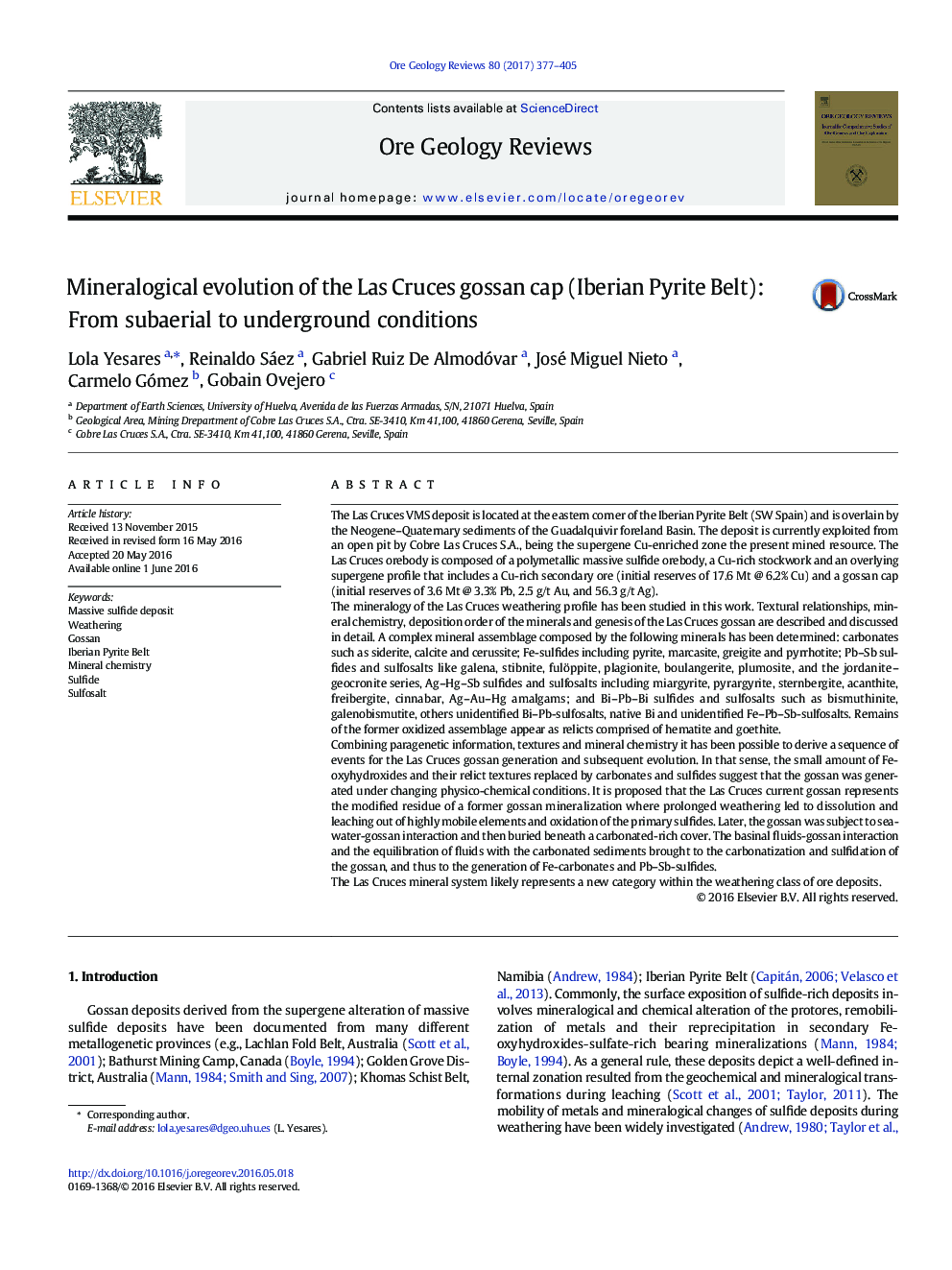| کد مقاله | کد نشریه | سال انتشار | مقاله انگلیسی | نسخه تمام متن |
|---|---|---|---|---|
| 6435617 | 1637226 | 2017 | 29 صفحه PDF | دانلود رایگان |
- First detailed mineralogical study of the uncommon Las Cruces weathered cap (Iberian Pyrite Belt)
- Description of mineral associations and its evolution from subaerial to underground conditions
- Role of carbonated sedimentary cover and the water-rock interaction processes
- Role of Alpine rejuvenated Variscan-fault for basinal fluids circulation and mineralogenesis
The Las Cruces VMS deposit is located at the eastern corner of the Iberian Pyrite Belt (SW Spain) and is overlain by the Neogene-Quaternary sediments of the Guadalquivir foreland Basin. The deposit is currently exploited from an open pit by Cobre Las Cruces S.A., being the supergene Cu-enriched zone the present mined resource. The Las Cruces orebody is composed of a polymetallic massive sulfide orebody, a Cu-rich stockwork and an overlying supergene profile that includes a Cu-rich secondary ore (initial reserves of 17.6 Mt @ 6.2% Cu) and a gossan cap (initial reserves of 3.6 Mt @ 3.3% Pb, 2.5Â g/t Au, and 56.3Â g/t Ag).The mineralogy of the Las Cruces weathering profile has been studied in this work. Textural relationships, mineral chemistry, deposition order of the minerals and genesis of the Las Cruces gossan are described and discussed in detail. A complex mineral assemblage composed by the following minerals has been determined: carbonates such as siderite, calcite and cerussite; Fe-sulfides including pyrite, marcasite, greigite and pyrrhotite; Pb-Sb sulfides and sulfosalts like galena, stibnite, fulöppite, plagionite, boulangerite, plumosite, and the jordanite-geocronite series, Ag-Hg-Sb sulfides and sulfosalts including miargyrite, pyrargyrite, sternbergite, acanthite, freibergite, cinnabar, Ag-Au-Hg amalgams; and Bi-Pb-Bi sulfides and sulfosalts such as bismuthinite, galenobismutite, others unidentified Bi-Pb-sulfosalts, native Bi and unidentified Fe-Pb-Sb-sulfosalts. Remains of the former oxidized assemblage appear as relicts comprised of hematite and goethite.Combining paragenetic information, textures and mineral chemistry it has been possible to derive a sequence of events for the Las Cruces gossan generation and subsequent evolution. In that sense, the small amount of Fe-oxyhydroxides and their relict textures replaced by carbonates and sulfides suggest that the gossan was generated under changing physico-chemical conditions. It is proposed that the Las Cruces current gossan represents the modified residue of a former gossan mineralization where prolonged weathering led to dissolution and leaching out of highly mobile elements and oxidation of the primary sulfides. Later, the gossan was subject to seawater-gossan interaction and then buried beneath a carbonated-rich cover. The basinal fluids-gossan interaction and the equilibration of fluids with the carbonated sediments brought to the carbonatization and sulfidation of the gossan, and thus to the generation of Fe-carbonates and Pb-Sb-sulfides.The Las Cruces mineral system likely represents a new category within the weathering class of ore deposits.
Journal: Ore Geology Reviews - Volume 80, January 2017, Pages 377-405
